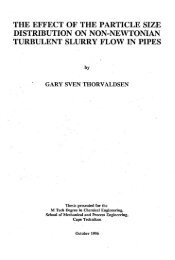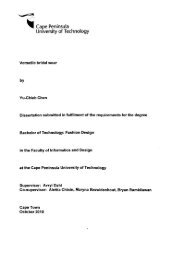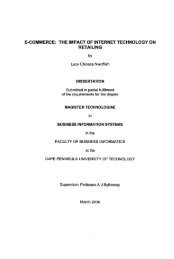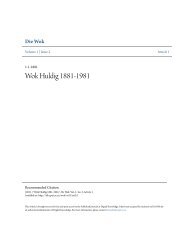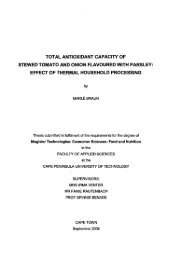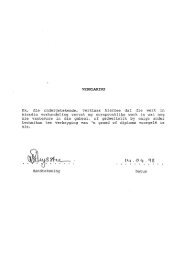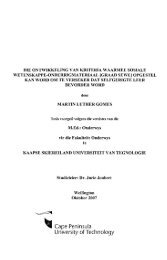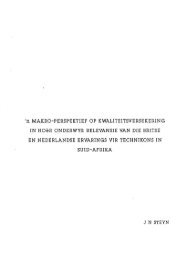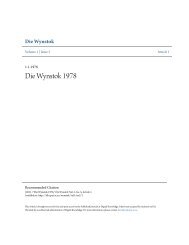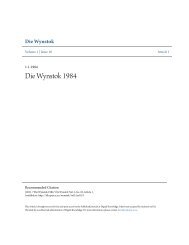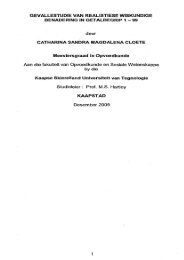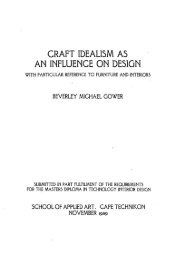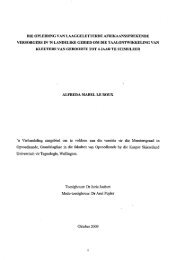an investigative analysis of the psychological characteristics and job ...
an investigative analysis of the psychological characteristics and job ...
an investigative analysis of the psychological characteristics and job ...
You also want an ePaper? Increase the reach of your titles
YUMPU automatically turns print PDFs into web optimized ePapers that Google loves.
Struwig <strong>an</strong>d Stead (2001:155) add that to underst<strong>an</strong>d how to <strong>an</strong>alyse a variable <strong>the</strong> researcher<br />
should know <strong>the</strong> various levels <strong>of</strong> measurement These levels <strong>of</strong> measurement include categorical<br />
levels <strong>of</strong> measurement (e.g. nominal or ordinal scales) <strong>an</strong>d continuous levels <strong>of</strong> measurement (e.g.<br />
interval <strong>an</strong>d ratio scales).<br />
3.6.1 Categorical Variables<br />
Categorical variables are measured in terms <strong>of</strong> classes or categories. Slruwig <strong>an</strong>d Stead<br />
(2001:154) distinguish between nominal-scaled responses <strong>an</strong>d ordinal-scaled responses. Nominal<br />
scaled responses have no numerical value <strong>an</strong>d produce data that fit into categories (Fink, 1995:4).<br />
Ordinal-scaled responses possess <strong>the</strong> power <strong>of</strong> r<strong>an</strong>k order. The researcher made use <strong>of</strong> <strong>an</strong> ordinal<br />
scale (e.g. <strong>an</strong>nually, monthly, weekly, daily) in apart <strong>of</strong> her final questionnaire.<br />
3.6.2 Continuous Variables<br />
According to Struwig <strong>an</strong>d Stead (2001:155), continuous variables c<strong>an</strong> be measured on a<br />
continuum ra<strong>the</strong>r th<strong>an</strong> in a class or category. There are two types <strong>of</strong> response categories, namely<br />
interval-scaled responses <strong>an</strong>d ratio-scaled responses. The researcher made use <strong>of</strong> interval-scaled<br />
responses for her study. The value or unit <strong>of</strong> measurement in <strong>the</strong> interval scale remains const<strong>an</strong>t<br />
throughout Its starting point is arbitrary. The differences between <strong>the</strong> scale values (e.g. essential,<br />
very import<strong>an</strong>t import<strong>an</strong>t <strong>an</strong>d not import<strong>an</strong>t) c<strong>an</strong> be me<strong>an</strong>ingfully interpreted. Each response<br />
category is one step away from <strong>the</strong> one before <strong>an</strong>d after it<br />
3.6.3 Data Analysis Techniques<br />
Struwig <strong>an</strong>d Stead (2001:156) mention that selecting <strong>the</strong> appropriate data <strong>an</strong>alysis technique is a<br />
complex process. The researcher <strong>an</strong>d <strong>the</strong> statistici<strong>an</strong> discussed <strong>the</strong> various variables to be<br />
<strong>an</strong>alysed <strong>an</strong>d <strong>the</strong> levels <strong>of</strong> measurement used. The data were once again screened for errors. It<br />
86



